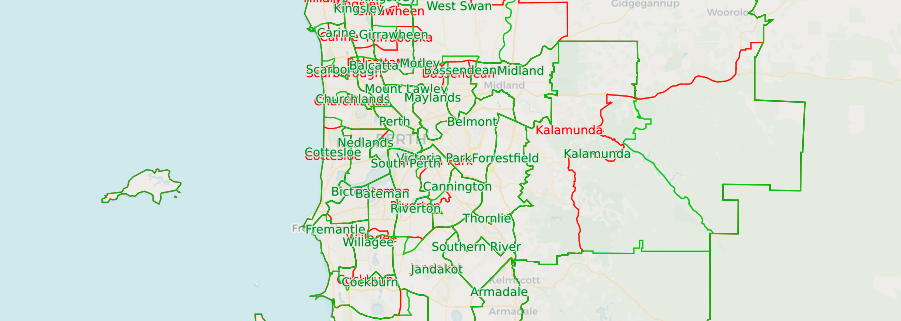The draft boundaries for the Western Australian state redistribution were released three weeks ago, but it has taken me some time to put together the map of the new boundaries, which are available for download now.
The commissioners implausibly managed to avoid moving an electorate from the country to the city despite a growing gap in enrolments.
Ten out of 59 seats were left with no changes. Most seats underwent small changes, with the most dramatic changes taking place in the north-east of Perth. The seats of Girrawheen and Mirrabooka were completely redrawn, with Girrawheen shifting south to take in much of Mirrabooka, and a new seat of Kingsway drawn in the northern half of Girrawheen. Kingsway is an unfortunate name for the new seat, being created right next door to the similarly-named Kingsley.
I haven’t yet done my own calculations about the new margins, but we can use William Bowe’s estimated margins, published at Poll Bludger.
William has one seat changing hands, with the Liberal seat of Hillarys, currently held by a 4.1% margin, turned into an effective dead heat with Labor just out in front. This seat was unusually close in 2017 thanks to the sitting Liberal MP running as an independent, and should be easily retained by the Liberal Party in 2021.
There are a number of marginal Labor seats where their position has been improved: from 5.8% to 8% in Balcatta, from 0.7% to 1.2% in Kingsley, from 2.5% to 4.9% in Burns Beach, from 1% to 2% in Jandakot, from 2.9% to 3.6% in Bicton, from 7.3% to 9.2% in Wanneroo, and from 1.4% to 2.3% in Murray Wellington. Labor’s margin in Joondalup has dropped from 0.6% to 0.1%.
You can toggle this map below to show the 2017 boundaries (red), the 2021 draft boundaries (green) or both.
You can download the Google Earth layers for both the Legislative Assembly and the Legislative Council from the maps page, along with WA electoral boundaries dating back to 2008.
The final electoral boundaries are due to be published by the end of November this year.




One of the weirdest quirks of the LDA is that rejig of the border between Pilbara and Kimberley. I’d be surprised if there was more than a few hundred people living in that area that’s been transferred, but with a bonus 1.5 “ghost” voters per 100 sq km, that’s how they get Kimberley a bit less under quota. It also makes life complicated around the edge of the wheatbelt – Central Wheatbelt and Roe are just over the 100,000 sq km threshold, so a small drop in area for them can result in a large change in notional voters, which they then have to make up from somewhere else that actually has people.
Another weirdness is the artificial city/country boundary between Rockingham and Mandurah councils. Ignore that, and you could probably create a new seat straddling those two councils, while pushing Mandurah across the estuary to take Dawesille’s surplus. There’s not much difference between Madora Bay and Singleton.
Darling Range getting moved south to lose half of Mundaring makes sense – now it’s a more Byford / Roleystone based seat, with all of Mundaring now in Kalamunda. They could’ve done more chopping and changing to get all of Ellenbrook in one seat, but apparently that was too hard. (I had a play with it – start with kinda recreating the 90’s seat of Helena, then you have to change boundaries all over the eastern suburbs, from Ballajura down to Forrestfield and in to Vic Park.)
In reply to Bird of Paradox, there are only 135 voters in the Gibson Desert section transferred from Pilbara to Kimberley, but sufficient LDA to push Kimberley well inside the 20.0% permitted deviation from quota. This is a conservative and responsible distribution that recognises that there is no need to abolish any seat or create a new seat (Kingsway/Girrawheen is a rejigged seat, not a new one).
Since 2007 no redistribution has crossed the Metropolitan Boundary line despite a number of submissions advocating this.
Correct, Ellenbrook/Aveley has become too large to fit within one district.
Comments are closed.